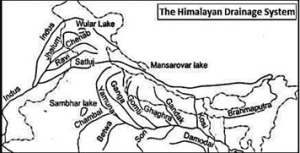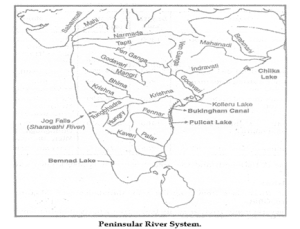Ans.
|
APPROACH Introduction- Briefly write about the drainage system of India and the key difference between the two types of river drainage systems. Mention that their characteristic features and evolution have been an outcome of three major geological events. The Body
Conclusion- Briefly write the influence of the geological history of the drainage systems in their main features, flow patterns and directions. |
Introduction: Indian drainage system comprises numerous big and small rivers within the Himalayan and Peninsular River systems. Three major physiographic events in the distant past, along with the differences in sources of the Himalayan and Peninsular rivers, have influenced the evolution of these river drainage systems.
While the Himalayan rivers are both glacier-fed and rainfall-fed, the Peninsular drainage system depends only on monsoonal precipitation, therefore, imparting it the seasonal character.
The Body
Evolution of Himalayan rivers:

The Himalayan River system has a long geological history, shaping its evolution and features. The most important geological events in this context are as follows:
- Existence of Mighty River during Miocene period: Geologists are of the opinion that there existed a mighty Shiwalik or Indo-Brahma River during the Miocene period some 5-24 million years ago, which was longitudinally extending from Assam to Punjab, further towards Sindh and finally discharging into the Gulf of Sindh.
Evidence supporting this view is the striking continuity of the Shiwalik and its lacustrine origin, as well as the alluvial deposits consisting of sands, silt, clay, boulders and conglomerates.
- The upheaval of Himalayas and Uplift of Potwar plateau: The Indo-Brahma river was eventually dismembered to form three separate river systems of Ganga, Brahmaputra and Indus, along with their tributaries. This was the outcome of the upheaval of the Himalayas during the Pleistocene period, including the upliftment of the Potwar plateau, thus giving rise to the Delhi ridge, which forms a water divide between the Indus and Ganga River drainage systems.
- Downthrusting of Malda Gap: During the mid-Pleistocene period, the flow of Ganga and Brahmaputra River systems was diverted towards the Bay of Bengal when there occurred downthrust of the Malda gap between the Rajmahal Hills and Meghalaya plateau.
Evolution of Peninsular Rivers:

According to the geological history of India, the following events have shaped the present drainage systems of Peninsular India:
- Subsidence of the western flank of the Peninsula: The early Tertiary period was marked by the subsidence of the western part of the Peninsular block that resulted in the submergence of the western part of the Peninsula in the Arabian Sea. This affected the symmetrical plan of the rivers on either side of the Western Ghats and divided the flow of some rivers eastwards and others westwards.
Examples of westward-flowing peninsular rivers are Narmada, Tapi, Periyar, Sabarmati etc., while the east-flowing Peninsular rivers include Godavari, Krishna, Kaveri, Mahanadi etc.
- The upheaval of the Himalayas and consequent faulting: There was another distortion in the flow of the Peninsular rivers when during the collision of the Indian plate with the Eurasian plate, the northern flank of the Peninsular block was subjected to subsidence, and this led to trough faulting through (rift valley) which now, the rivers Narmada and Tapi flow. There is a lack of alluvial and deltaic deposits in these rivers.
Evidence in this regard is provided by the straight coastline, steep western slope of the Western Ghats and no delta formations on the western coast.
- Tilt in Peninsular block: The orientation of the Peninsular rivers towards the Bay of Bengal is explained as an outcome of the slight tilting of the peninsular block from North-West to South-East.
Conclusion:
Thus, the geological events have affected the direction of flow of rivers, their pattern of drainage system as well as their other characteristic features like delta formation, meandering, carving of gorges, V-shaped valleys, cascades, waterfalls, etc. while traversing through different types of relief in the country.
Spread the Word
